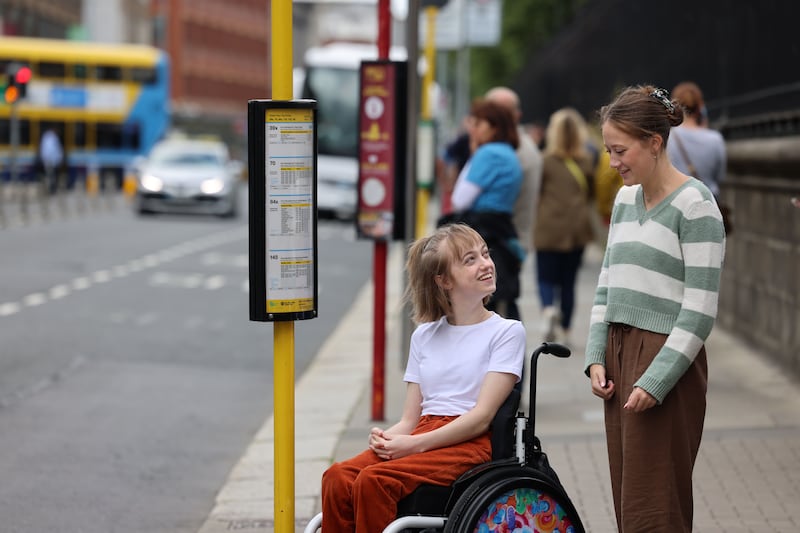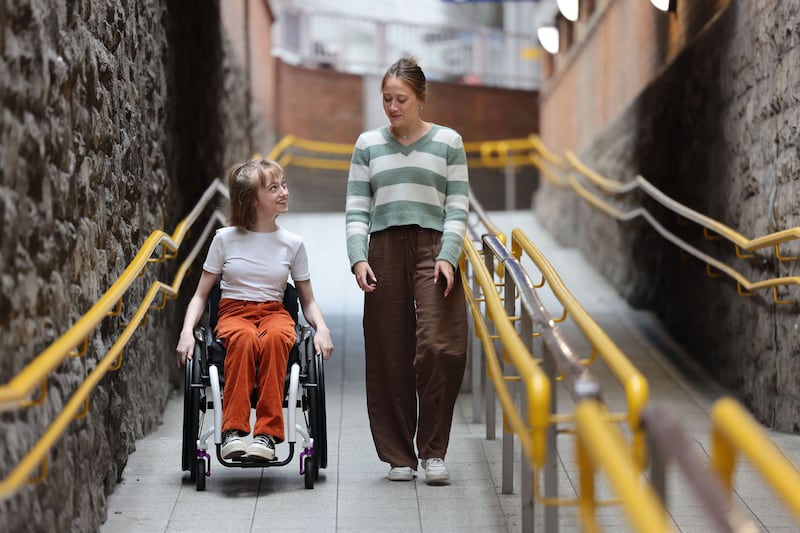A special Teenage Edition of the Magazine this weekend features articles written by aspiring young journalists on issues that matter to them, from the impact of TikTok on their lives, to accessibility, sustainable fashion, making music, and keeping young women playing sport.
I’m waiting for a bus in a south Dublin suburb with my friend Emma. The sun is shining, and I’m excited at the prospect of a day out in Dublin. I’d like to say excitement is all I’m feeling but as a teenager with a disability – I have cerebral palsy – and a wheelchair user, there are mixed emotions: fear and worry with a generous side order of existential dread. These feelings are not groundless. They are based on years of trying to navigate the city I call home on four wheels. As the bus approaches I try my best to push these negative feelings down. I’ve got coupons for free coffee in my pocket and a day of retail therapy and ice-cream ahead.
A bus approaches, then slows to a stop. Looking through the window, we notice that the only wheelchair space on the bus is already occupied. I observe a flash of guilt, completely unwarranted, flit across my fellow wheelchair user’s face. It’s not their fault that we can’t share a bus together. It’s a flawed system. We share a wordless, pained exchange and I imagine a Dublin where two people in wheelchairs could sit on a bus together, guilt and worry-free. The door closes on both of us. Ah, well. There’ll be another one along soon.
The following bus has space for me and my wheelchair. I celebrate this small win and do my best to ignore the “warning wheelchair ramp opening” chant which blares loudly from the speakers. Being in a wheelchair means you are never allowed a discrete arrival on a bus. It’s difficult to explain how severely this impacts my dignity. Every eye on the bus staring as though they’ve never seen a young woman in a wheelchair before. A few stops later, the driver is forced to turn away another wheelchair user, and I find myself feeling my predecessor’s guilt. I mouth an apology they’ll never hear through the pane of glass between us, and we move away.
RM Block
Next stop is Glenageary Dart station where I say an anxious prayer to the patron saint of public transport that the lifts are working. (St Anthony is the patron saint of travelling, he’ll have to do.) When I’m on my own, using public transport requires many pre-trip phone calls and website checks. Is the lift working? Are there ramps available? Nothing can be left to chance. As a wheelchair user, there is no opportunity for spur-of-the-moment jaunts into town, or anywhere else for that matter.
Thankfully, the lifts are working. We are barely a minute on the platform when we’re approached by a rather frustrated Dart worker who tells us the platform has no ramp available today. If I were on my own, that would be the end of my day out, but luckily, I have Emma to help me on to the train. It’s a tense moment. We worry my wheels will get stuck in the gap between the train and the platform, or that the doors will close too soon. I can’t help wondering, not for the first time, why the Dart and Luas do not facilitate the same automatic boarding ramps we see on buses. Or why they’ve not invested in that ingeniously simple system I’ve seen in London where certain parts of the platform are raised to facilitate people with mobility issues. This would make it much easier for us to board. We arrive at Pearse Street Dart station a little weary from the various travel issues, but with a buzz of achievement from having made it this far.

We head to get food. It should be straightforward, making our way to my favourite city-centre cafe. You will likely not be shocked to discover it is not straightforward. We’re met with a Total Wipeout obstacle course of cobblestones, broken paths, narrow pavements, bulging tree roots, broken glass and an unfathomable amount of dog poo. Add to this list any number of inconsiderate, oblivious drivers who have parked on footpaths, making it impossible to pass. Wheeling through town is like being in a frustrating video game. Emma and I are dodging the bad guys left, right and centre to reach the holy grail – the city’s finest chicken Caesar salad bagel.

Too much Tubridy: What Irish teenagers think of the news
This weekend, for the first time, the content of The Irish Times Magazine will be written entirely by teenagers. The six volunteers tackle subjects including the pitfalls of Tiktok, why many young women drop out of sport and what it is like to be a wheelchair user. One of their mentors for the project was Patrick Freyne, who recorded a conversation with them about the way their generation consumes news and the issues they really care about.
When we get to the cafe, I reflect again on the fact that I simply would not have been able to make it there alone if it weren’t for Emma. This reliance on others caused by all of these easily fixable structural issues chips away at my independence.
In the cafe, the lunchtime rush is well under way. Time to use the lessons I learned in drama class. I do my best-exaggerated miming, trying to get the attention of the woman behind the counter. As usual, being at waist level is proving challenging. I need my friend to order for me. My own voice, once again, going unheard.

After lunch, I find some freedom in Merrion Square Park. Freewheeling at full speed down hills is like having my own private rollercoaster. I get to be in control for once, and the shocked looks on the faces of strangers as I hurtle along make me smile. Back on the bumpy streets, we rattle and roll toward the shops in search of some retail therapy.
Choices are limited. I’m a vintage-loving girl, but charity shops are generally cramped and difficult to navigate. The huge retailers offer expansive floors on which I could spin for days but lack the looks and styles I love. Wherever I go, I’ll have to deal with the disappointment of grasping for hangers I know I’ll never reach. Being in a wheelchair on a shopping trip means constantly having to ask for assistance. It can feel degrading. The world is not set up to accommodate people like me and I’m forcibly reminded of that everywhere I go. We make the most of the day. I buy a cardigan, some lip balm and a gift for a friend’s birthday (no spoilers). Bags on my lap, coffee vouchers well spent and plenty of ice-cream consumed, Emma and I brace ourselves for the obstacle course that is (cue dramatic movie mood music): The Return Journey Home.
Is it too much to hope that one day we might live in an Ireland that has adapted to suit the needs of all its citizens? Maybe
It’s been a day of hurdles, ones I could have easily jumped if I were able to walk. Instead, I’ve had to find ways around them. I can’t speak for every wheelchair user or every teenager with mobility issues, but from my personal experience, the lack of thought about people like me puts up unnecessary barriers when it comes to socialising, having fun and being independent.
These things, taken for granted by so many people, are integral to the basic “coming of age” experience. And yet the disabled community continues to be left behind.
Ireland’s inaccessibility affects so many communities: the disabled, the elderly, those with injuries, chronic illness, chronic pain and more. New parents with buggies and baby paraphernalia are not well served either by dodgy pavements, broken lifts and missing ramps.
One day you could find yourself affected by it too. Future generations with disabilities deserve to share the freedom of their peers. They deserve to leave the house without anxiety and experience the joys of independence without being held back. The introduction of clever ideas seen in other countries such as raising tram platforms, automated ramps and lower checkout points in shops would go a long way in making us feel accepted and heard. Whether walkers or wheelers or pram pushers, we all deserve dignity and autonomy. Is it too much to hope that one day we might live in an Ireland that has adapted to suit the needs of all its citizens? Maybe. But I will keep on hoping.
Niamh Moriarty was mentored by Irish Times journalist Róisin Ingle






















